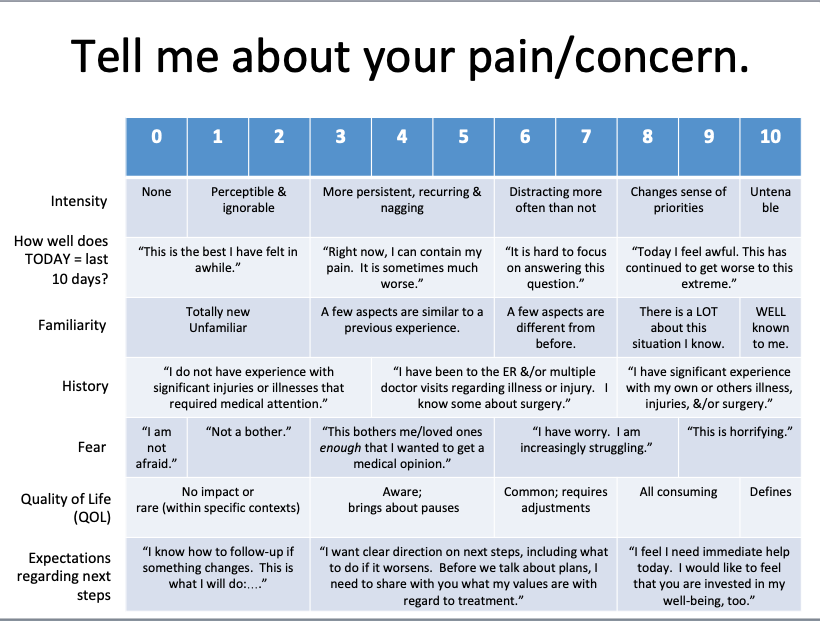For not being a particularly mathematically-minded person, I have found a surprising effectiveness for using rating scales across a range of circumstances as a way of characterizing a state of being, communicating needs, and making plans. Downloadable .pdf

I was working with a man dying of ALS when I first realized that the method of using 0 to 10 to describe pain was inadequate — typically, this is used to say that 0 = no pain, and 10 is the worst pain you personally have ever felt in your life. For this man, he had chronic tooth pain and he knew there was nothing that could be done about it. As a stand-alone prompt: Does he answer the question for how he FEELS (serious pain), or is that a source of frustration since there was no relieving it? If given the opportunity to follow-up with a characterization of familiarity, fear, or expectation regarding next steps, he consistently reported that he did not want this issue to be the focus of his limited time and energy. As I began adapting this approach with myself, my family, and persons I worked with, I have been increasingly convinced that the follow-up questions are critical.
A guiding principle I try to encourage is to regard a “4” as an important opportunity of awareness. This is the point where steps need to be taken because waiting until after this will surely mean more intensive responses will be required and will take longer to have a positive effect. For example, with a headache, a 4 may mean drinking water, taking a break from technology screens, rest, and quiet. Waiting until a headache is past a 4 may well mean over the counter medication (which can take up to 45 minutes to have an effect and sometimes comes with a stomach upset), separating self from others to have dark, stillness, and silence. With emotional well-being, a 4-level of loneliness, sorrow, grief, and worry has actionable responses encouraging drinking water, connecting with trusted loved ones and conversations with counselors or mentors, spending time in relation to nature, meditation, yoga or prayer. Above a level 4 can get entangled in withdrawal, shame, resentment, depression and anxiety — these also have actionable responses, and can be compromised by related feelings of loss including of motivation or hope. Despair may well mean more precisely constructed responses with persons whose expertise is in navigating complex emotions and acquiring those appointments may take a substantial amount of (wretched) waiting time. The essential medications and therapies typically take some days to provide the necessary space for reflection and healing.
In short, it is not brave or stoic to actively not acknowledge pain/concern.
In future revisions of the chart, I may consider it more vertically, with the descriptions of the levels on one side and tiered responses on the other. Or posing an additional follow-up question, which I might characterize as “distance from functional.” As I type this, I am aware of a neck-shoulder-back pain that I woke up with. Overall, it is more of an ominous feeling of caution not to turn my head (at all), with swift and sharp pinches which stop me immediately. This is a familiar pain plus I am not afraid of it; however, I am aware that if I do not take effective steps it will be extremely difficult for me to cook dinner later (it’s my turn tonight), or even undress. Since meal preparation and clothing are basic activities of daily living (ADLs), it struck me that even a relatively minor pain/concern can have a debilitating impact on functioning. This is a different perspective on why recognizing how much of a problem a situation is becomes critical to pacing existing reserves. The increments from functioning are not necessarily of equal measure; that is, it may take awhile for a 3 to eke into a 4 but a 6 can jump to a hard 8 just because of a tense and unanticipated sneeze.
“It is not brave or stoic to actively not acknowledge pain/concern.” That’s true, but too short. a key word is “actively” because being aware of one’s own pain, concerns, and distance from functioning can be uniquely unsettling itself. Possibly because we don’t tend to talk much about this openly, it takes on a secret status and the things we don’t tell can take on a character of private disappointment all on their own. I don’t know that people intentionally choose denial. It seems more likely the default and conditioned response of being uncomfortable with notions of weakness, vulnerability, and potential to be ‘burden’.
For now, it is time for me to stop typing — I need to drink water, stretch, and find release between my shoulder blades.
End blip.